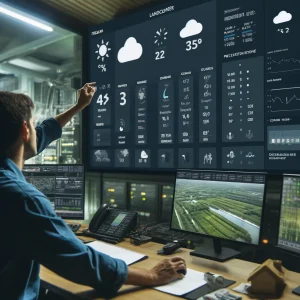In the landscaping industry, the weather is a crucial factor that can significantly impact the success and efficiency of projects. Advanced weather tracking systems provide landscapers with valuable data, allowing them to effectively plan tasks around weather conditions. By leveraging these systems, landscapers can improve efficiency, ensure safety, and enhance the overall quality of their work. This blog post will explore the benefits of weather tracking systems, the types of weather data they offer, and practical tips for integrating this information into daily landscaping routines.

Benefits of Using Weather Tracking Systems
Weather tracking systems offer several advantages for landscapers:
- Improved Efficiency: By knowing the forecast, landscapers can schedule weather-sensitive tasks, such as planting, mowing, or applying pesticides, during optimal conditions. This prevents delays and ensures that tasks are completed on time.
- Enhanced Safety: Weather data can alert landscapers to hazardous conditions like thunderstorms, high winds, or extreme heat. This allows them to take necessary precautions or reschedule work to ensure the safety of their crew.
- Better Resource Management: Understanding weather patterns helps plan the use of resources such as water, fertilizers, and labour. For example, knowing when it will rain can help schedule irrigation, thus conserving water.
- Increased Client Satisfaction: Providing clients with accurate timelines and delivering quality work despite weather challenges can enhance client trust and satisfaction.

Types of Weather Data Provided
Advanced weather tracking systems offer a range of data types that are useful for landscapers:
- Temperature and Humidity: These parameters help plan tasks like planting, which require specific temperature ranges for optimal growth.
- Precipitation Forecast: Knowing when it will rain or snow helps schedule irrigation and planning tasks requiring dry conditions.
- Wind Speed and Direction: High winds can make specific tasks like spraying pesticides unsafe. Wind data helps in scheduling such tasks appropriately.
- Severe Weather Alerts: Alerts for thunderstorms, tornadoes, or extreme weather conditions enable landscapers to take precautions and ensure the safety of their crew and equipment.
Examples of Popular Weather Tracking Tools
Several weather-tracking tools can be particularly beneficial for landscapers:
- Weather Underground: This tool provides hyper-local weather forecasts, severe weather alerts, and radar imagery. It is known for its accuracy and detailed data, which can help landscapers plan their tasks effectively.
- AccuWeather: AccuWeather offers comprehensive weather information, including minute-by-minute forecasts, severe weather alerts, and extended forecasts. Its user-friendly interface makes it easy for landscapers to access the needed data.
- WeatherBug: WeatherBug provides real-time weather data, lightning alerts, and detailed forecasts. Its interactive radar maps and severe weather alerts help landscapers stay informed about changing weather conditions.

Practical Tips for Integrating Weather Data
Here are some practical tips for landscapers to integrate weather data into their daily routines:
- Daily Weather Check: Make it a habit to check the weather forecast at the start of each day. Use this information to plan the day’s tasks and allocate resources efficiently.
- Adjust Schedules: Be flexible with scheduling. If the forecast predicts rain in the afternoon, plan to complete outdoor tasks in the morning and move indoor tasks or equipment maintenance to the afternoon.
- Use Alerts: Set up severe weather alerts on your weather tracking app. This will ensure you receive timely notifications about hazardous conditions, allowing you to take necessary precautions.
- Plan for Seasonal Changes: Use long-term forecasts to prepare for seasonal changes. This can help you plan major projects and ensure you have the necessary resources.
- Educate Your Team: Ensure that your team knows the importance of weather data and knows how to access and interpret it. This will enable them to make informed decisions on the job.
Advanced weather tracking systems are invaluable tools for landscapers. They provide essential data that can significantly enhance the planning and execution of landscaping tasks. By utilizing these systems, landscapers can improve efficiency, ensure safety, and deliver high-quality work regardless of weather challenges. Integrating weather data into daily routines benefits the landscaper and enhances client satisfaction and trust. Embracing these technologies is a smart move for any landscaping business looking to stay ahead of the curve.
